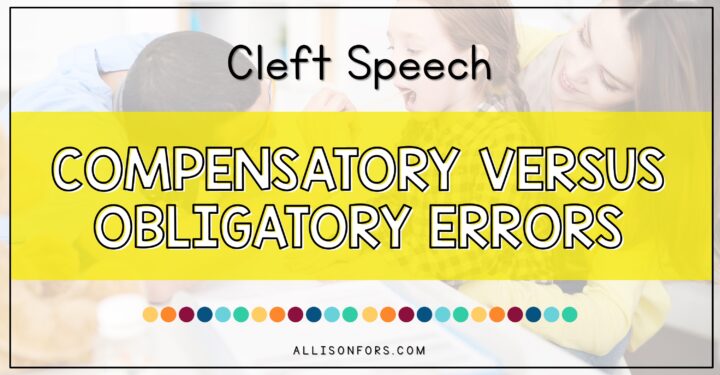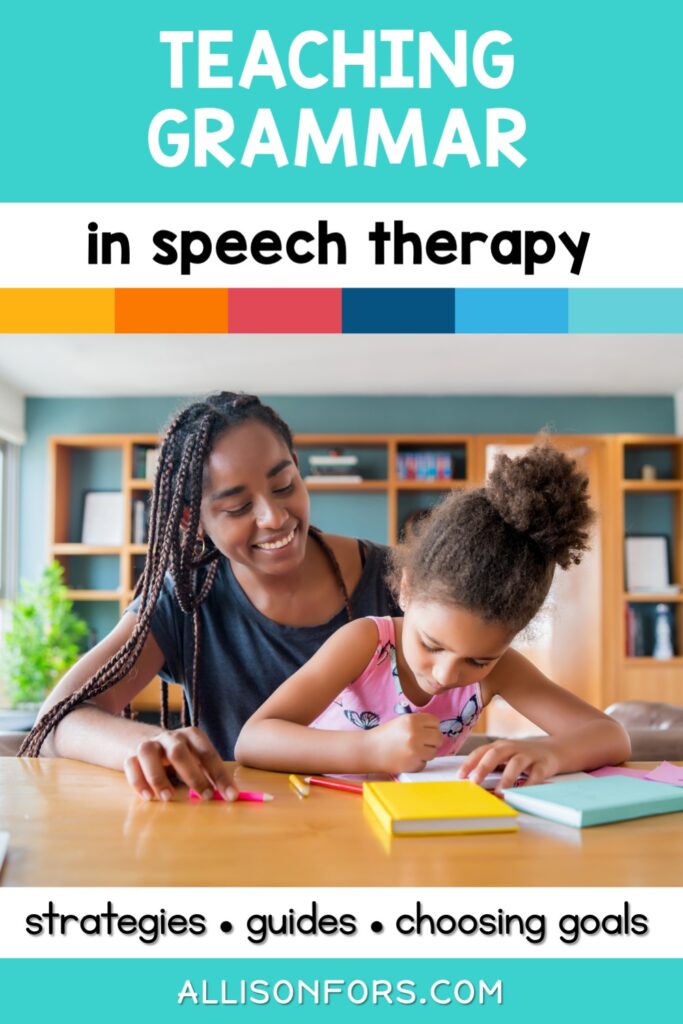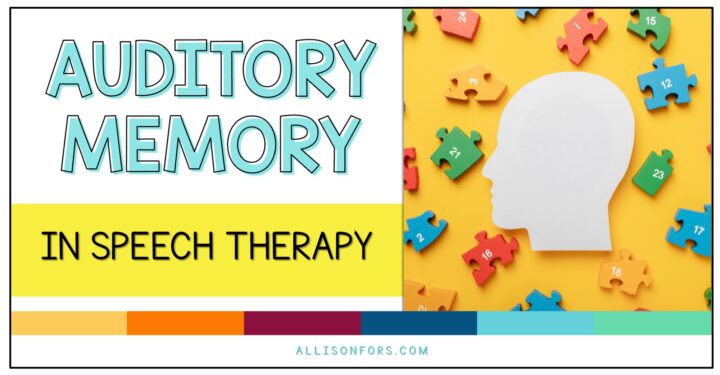
Teaching Grammar in Speech Therapy

Grammar is an integral part of language intervention and communication.
Why do Speech Pathologists teach grammar?
Teaching grammar is an essential part of speech therapy because it directly relates to language skills and communication. Grammatical difficulties may be found with individuals who have developmental language disorder, a hearing impairment, or complex communication needs. Not only is grammar critical to communication, but academic success – speaking, comprehension, reading, and writing. Our goal is to help our students gain a greater grasp of syntax and morphology to help them in meaningful communication, whether in conversation or writing skills.
Grammar is an essential skill that impacts many other skills.

We can group grammar skills into 2 main areas: syntax and morphology.
Syntax is the study of how we arrange words and phrases to form sentences. Syntax requires understanding and use of correct word order and organization.
The English language follows a subject-verb-object word order. For example, “Camille loves the dog.” Switching the word order of this basic sentence can create a much different meaning, “The dog loves Camille.”
Another rule is that each sentence must contain a noun phrase and a verb phrase. Within noun and verb phrases, there are rules and predictable patterns. For example, articles appear before nouns, and adverbs modify verbs.
Morphology is the study of the structure and construction of words. It is the aspect of language that deals with the rules that change word meaning, such as roots, prefixes, and affixes.
A morpheme is the smallest unit of meaning. For example, “eat” is one morpheme, while “eating” is two morphemes – “eat” holds its own meaning, and “ing” signifies the present progressive tense. Another example, “watermelons” is three morphemes, “water” and “melon” are two stand-alone words and “-s” is the plural suffix.
Grammatical morphemes, such as “-s”, “–ing”, and prefixes and suffixes such as “pre-”, “-ly”, “-er” are necessary for language development. They aid in expanding vocabulary and using more complex words.
Children with specific language impairment have greater difficulty with morphological concepts such as verbs, verb endings, tenses, and verb phrases. They are more likely to use an auxiliary verb if it is in the preceding sentence. Both form and location must be considered.
Grammar Teaching Strategies
“Binger et al. (2020) argue that instructors should focus on all areas of language, including grammar—even for young children, children with limited intelligibility, or children with limited vocabularies. In another article, Curran (2020) points out that because children in elementary school are expected to read and listen to complex sentences as early as third grade, SLPs should target these types of sentences during treatment in order to help the child succeed in the classroom.”
https://academy.pubs.asha.org/2020/04/lshss-forum-highlights-the-importance-of-grammar-education-and-treatment/
Research also supports both explicit instruction and implicit methods. In fact, combining both explicit and implicit is more effective than implicit treatment alone!
Explicit instruction: This is directly teaching the rules of grammar forms and is usually done with structured activities. For example, you can teach the rule, then practice while giving feedback on the production. Some examples are Shape Coding or cueing.
Implicit instruction: This is giving exposure without direct teaching of the concept or grammar rule. Examples of implicit instruction are modeling and recasting. Modeling is when you provide the correct grammatical example. Recasting is when you rephrase the incorrect sentence to be grammatically correct. For example, during a play activity, you can model a verb tense while playing and emphasize the morpheme.
You can combine these two strategies. For example, if you are teaching regular past tense verbs, you may explicitly teach that the verb ending changes to show the action already occurred and explain the different endings -d, -t, -Id. You may implicitly teach by correcting the student’s incorrect past tense production by repeating it back correctly.
Choosing Grammar Goals
Take language samples to ensure you get a look at a variety of morphemes or syntax. If you’re struggling with what grammar goals to work on, do a formal or informal assessment and pair that with The Informed SLP Grammar Guide or the Grammar Development Handouts.
SUGAR Language Analysis Method – This FREE program analyzes language samples.
Tips for Taking Language Samples – This blog post contains tips for taking language samples, how to encourage student participation, and tools for collecting and analyzing them.
FREE Language Sample Checklist – This is a one-page language screener. It includes syntax, morphology, narratives, and pragmatics sections.
Grammar Guides
Grammar Development Handouts – This resource outlines the big-picture of grammar acquisition in early childhood. It reviews the different aspects of syntactic structures, why they are critical for communication, and what makes them especially difficult. It goes into depth on syntax, morphology, mean length utterance, as well as common morphological and syntactic errors.
The Informed SLP Grammar Guide – Great for choosing targets with a suggested order of grammar skills to work on. Gives examples with the shape coding system.
You may also be interested in reading:
Grammar Activities for Speech Therapy
A Better Way to Teach Past Tense Verbs
A Better Way to Teach Irregular Plurals

Binger, C., Kent-Walsh, J., Harrington, N., & Hollerbach, Q. C. (2020 Tracking early sentence-building progress in graphic symbol communication. Language, Speech, and Hearing Services in Schools, 51(2), 317–328. https://doi.org/10.1044/2019_LSHSS-19-00065
Curran, M. (2020). Complex sentences in an elementary science curriculum: A research note. Language, Speech, and Hearing Services in Schools, 51(2), 329–335. https://doi.org/10.1044/2019_LSHSS-19-00064
If this post was helpful, please share it!








